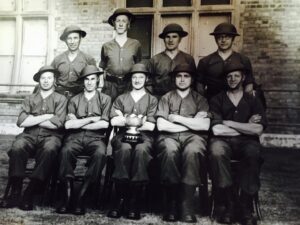The Stalemate of ‘The Phoney War’ ended on 10 May 1940 with a massive German offensive in northwest Europe and our army in full retreat. Invasion seemed to be a real possibility.
On the evening of 14 May 1940 the Secretary of State for War, Anthony Eden, gave a radio broadcast announcing the formation of the Local Defence Volunteers [LDV] and called for volunteers to join the force. In the radio announcement, Eden called on men between the ages of 17 and 65 in Britain, who were not in military service but wished to defend their country against an invasion, to enrol in the LDV at their local police station.
In Bexhill 460 men went to the Police Station and the Little Common British Legion. Their immediate duty was a nightly watch for parachutists as well as manning important points such as the Report Centre, Gas works, Water Works and various road blocks.This concern with a parachute borne invasion led to the Volunteers being known as parashooters. In addition the humorous nickname ‘Look Duck and Vanish’ became popular.

Bexhill’s volunteers were organised as the 24th Battalion of the Sussex Home Guard. The first commanding officer was Captain Paul Sainsbury of Beaulieu Road who set up his headquarters at the Little Common British Legion clubhouse. The battalion’s initial armament comprised 23 shotguns and 6 .22 miniature rifles.Defence zones were established as the Town Hall, Bexhill Golf Links, Little Common, Bexhill Down, Sidley Green and Bexhill Hospital. The hurried organisation had fallen into place by July 1940 by which time the volunteers had been renamed the Home Guard and members paraded in public uniformed and armed.
The headquarters had moved to the Drill Hall and weekend camps were held at Barnhorn, Worsham Manor and Preston House. A rifle range was established at the Turkey Road brickworks.

When air raids started the Home Guard lost their first man, Volunteer Jack Croft of North Road, a plumber, who was killed whilst working at a house in Buckhurst Road. In later raids Volunteer Sydney Apps of De La Warr Road rescued an elderly woman alive from 10 Cantelupe Road and Volunteer Apps, along with Platoon Commander Henry Hyde of St Leonards Road, entered Collis’s chemist shop in St Leonards Road searching for the proprietor Leslie Collis who had been killed during the raid.
At some stage later in 1940 the Sidley Platoon were roused from their beds and went to the prepared positions at the Turkey Road and Peartree Lane junction and waited there with Molotov cocktails and rifles for an enemy who never came. In addition parachutists were reported at night in the Whydown area. A search was made without result.
In March 1941, the Bexhill Home Guard was transferred into the 23rd Hastings Battalion becoming the 23rd’s U X Y Z Companies. Attendance at the Drill Hall was maintained at two evenings a week for training. The year continued with the routines of security and patrol. Day and night. Every day.

The level of experience and training were taken to a new level in June 1942 when two weeks were spent undergoing regular army weapons training and methods with Canadian troops. The fortnight culminated during the final weekend as Operation FOX, in which the 23rd defended Bexhill and Hastings against attack by the Canadians. Assuming the ‘enemy’ to have come by sea and air, the Home Guard successfully fought off attacks on their roadblocks and captured enemy dispatch riders. In Hastings the Home Guard captured a troop of anti-tank guns and disabled a tank as well.
Later in the year the Bexhill companies merged into the 23rd’s D and E companies and time was being spent manning the guns of 301 Coastal Battery along the seafront opposite the Sackville Hotel. The battery’s headquarters was at Carlton and Newdigate House Hotels.

In the June of 1943 a public display was mounted of weapons and tactics. As part of the display the cricket pavilion on the Down was assaulted and captured. A Civil Defence Platoon was formed from those already serving in such areas as air raid wardens and firemen. The thinking being that in battle an armed force would be of more use than protection of the civilian population. At its peak in 1944 the Platoon mustered 72 men.
In the September of 1943 Home Guard Royal Artillery detachments were formed and the Home Guards manning 301 Battery became part of the Royal Artillery. As well as these duties the Home Guard supplemented the effort of the Royal Observer Corps and lookout was maintained for German planes. The observation post was the veranda of a house on the corner of the Highwoods Avenue and Peartree Lane.
The Bexhill Home Guard had often been awarded accolades on its efficiency and effectiveness. The pinnacle was in June 1944 when a nine man team from 301 Coast Battery won a dummy loader competition winning a silver bowl at Newhaven Fort. Previously it had only been open for competition by regulars. Their winning score was 102 ½ points. Their average age was 38.

Rifle competitions were also popular 62 of the 88 members of the battery attended rifle shooting competitions scoring high and often winning scores. Home Guard strength was now dissipating and by Stand Down 50% of strength was provided by the local Royal Artillery Cadets.
Stand Down was on 03 December and 350 men formally paraded. At this time the Bexhill units comprised the Coastal Battery, the Civil Defence Platoon and D Company. Their esprit de corps did not suddenly evaporate. Into 1946 reunions and dinners took place and a presentation of £150 to Bexhill Hospital was made from remaining Home Guard canteen funds to endow a bed.
It is thought that over 800 local men served in the local Home Guard, 20 of which did two periods of service. The oldest man was probably Thomas Nightingale of Beaconsfield Road, born 1873 and the youngest was probably Robert Welford of Bayencourt North, born 1927.



